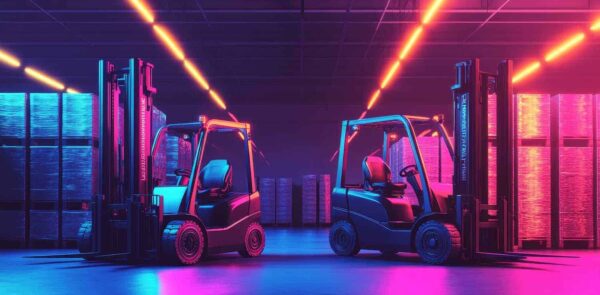
Jump to a section:
Machinery and equipment manufacturers often grapple with a unique marketing challenge: how do you convey the power, precision, and innovation of heavy-duty products in a way that captivates potential buyers? Text-based spec sheets can only go so far. That’s where videography comes into play. From showcasing equipment in action on a large construction site to capturing the nuanced engineering process behind each product, video content provides an immersive experience that resonates with technical teams and non-technical stakeholders alike.
Understanding the Power of Video for Machinery Brands
As digital consumption continues to grow, video has emerged as one of the most persuasive forms of content marketing across industries.
Visualizing Complex Mechanics
- Why It’s Powerful: Technical brochures or CAD diagrams can be confusing for some buyers. Videos illustrate mechanical movements, product functionality, and real-world performance.
- Impact: Prospects get a clearer understanding of how your machinery operates, boosting trust and reducing pre-purchase uncertainties.
Demonstrating Real-World Impact
- Why It’s Powerful: Showcasing machinery in action—like an excavator on a job site or a packaging machine in a factory—makes the use case tangible.
- Impact: Potential clients can envision how your solution fits into their operations and addresses their pain points.
Humanizing a Technical Industry
- Why It’s Powerful: Interviews with engineers, plant managers, or satisfied customers highlight the human expertise and dedication behind complex machinery.
- Impact: Builds emotional connections and a sense of reliability, vital for big-ticket B2B sales.
Stat to Note: A 2022 Wyzowl study found that 88% of people reported being convinced to buy a product or service after watching a brand’s video. The effect can be even greater in high-investment B2B contexts where visual clarity is crucial.
Crafting Your Narrative: Beyond Specs and Features
While product specs and efficiency rates are important, compelling brand storytelling focuses on the “why” behind your machinery.
Origins and Mission
- Angle: Share how your company began—perhaps your founders were frustrated by subpar equipment and set out to build something better.
- Emotional Hook: Highlights authenticity, passion, and problem-solving.
Innovation and Problem-Solving
- Angle: Center your story on the challenges your machinery addresses—be it reducing downtime, speeding up production, or enabling environmentally friendly practices.
- Emotional Hook: Aligns your brand with problem-solving and productivity gains, resonating with end-users.
Customer Success Stories
- Angle: Instead of bragging about your brand, let your clients tell the story—how your machinery helped them overcome a hurdle or achieve record output.
- Emotional Hook: Social proof from respected industry peers is incredibly powerful. It says, “This worked for us, and it can work for you.”
Behind-the-Scenes Glimpse
- Angle: Show the manufacturing process, R&D labs, or the daily operations at your facility.
- Emotional Hook: Reinforces transparency, craftsmanship, and quality control.
Pro Tip: Keep your narrative consistent across all videos. Whether it’s a product demo or a corporate overview, elements of your brand story—innovation, reliability, safety—should always shine through.
Types of Videos to Showcase Your Brand Story
Machinery manufacturers have a wide range of video formats to choose from, each serving a distinct purpose.
Corporate Overview
- Focus: High-level introduction to your company’s history, values, product lines, and corporate culture.
- Length: 2–3 minutes is typically enough to keep it engaging.
- Distribution: Company website homepage, social media profiles, and trade show loops.
Product Demonstrations
- Focus: Detailed look at how a specific machine operates, including features, performance metrics, and real-world applications.
- Length: 3–5 minutes, though you can create shorter highlights for social media.
- Distribution: YouTube channel, email campaigns, product pages, sales presentations.
Customer Testimonials and Case Studies
- Focus: Interviews with real clients showing how your machinery solved a specific problem.
- Length: 2–4 minutes, enough time to set up the challenge and show the solution.
- Distribution: Sales meetings, website’s “Success Stories” section, social proof in digital ad campaigns.
Factory Tours or Behind-the-Scenes
- Focus: Showcase your manufacturing process, quality control steps, or the team behind the machines.
- Length: 2–3 minutes, focusing on the most compelling aspects.
- Distribution: Website, YouTube, social channels (especially LinkedIn for B2B).
How-To and Maintenance Guides
- Focus: Provide post-purchase support, explaining routine maintenance or minor troubleshooting.
- Length: 1–5 minutes, depending on complexity.
- Distribution: Customer portals, YouTube playlist for customer support, QR codes on machine manuals.
Thought Leadership and Webinars
- Focus: Topics like industry trends, new technology insights, or best practices in machinery usage.
- Length: 15–45 minutes for in-depth content.
- Distribution: Live or recorded webinar platforms, LinkedIn posts, email nurturing sequences.
Stat Spotlight: A 2021 Vidyard report indicated that 60% of B2B customers prefer video over text when learning about a product’s features, making product demonstrations and case studies key formats.
Production Considerations: Equipment, Locations, and Safety
Filming large machinery comes with logistical and safety concerns. Proper planning ensures a smooth shoot and maintains credibility.
Scouting the Right Location
- Options: Filming at your facility, a client’s site, or a neutral environment like a test field.
- Prep: Secure necessary permissions, ensure you have adequate lighting and space to maneuver cameras safely.
Equipment and Crew
- Camera Gear: High-quality cameras with the capability for slow-motion or 4K footage can capture detailed shots of moving parts.
- Sound Equipment: For interviews or narration, invest in good microphones.
- Drone Footage: Great for capturing scale, especially for large outdoor machinery. However, follow local drone regulations.
Safety Measures
- Coordination: Plan with safety officers or supervisors on-site.
- Protective Equipment: Helmets, safety vests, goggles—whatever is required for a real job site.
- Contingency: Have a plan if filming needs to pause due to site rules or equipment breakdowns.
Scheduling
- Timing: Machinery usage often depends on work schedules. Consider filming after production hours if necessary or coordinate “on-the-job” shoots during lower-risk operations.
- Crew Coordination: Ensure everyone, from engineers to camera operators, has a clear timeline.
Pro Tip: Create a shot list specifying the must-have angles and features (like close-ups of assembly lines or wide shots of the entire facility). This helps the crew stay organized and capture all essential footage in minimal time.
Editing and Post-Production: Adding Polish to Your Story
Filming is only half the battle; post-production is where your brand story truly comes to life.
Editing Style
- Approach: Keep it clean and professional, using dynamic cuts to maintain viewer interest.
- Visual Aids: Insert graphics, callouts for key specifications, or overlays to highlight crucial performance data.
Music and Sound Design
- Role: Background music sets tone—could be energetic for heavy machinery demos, or more cinematic for brand overviews.
- Challenge: Ensure it doesn’t overpower spoken content. Consider using sound effects to emphasize mechanical parts but keep it tasteful.
Narration and Subtitles
- Benefit: Voiceovers can unify your footage and clarify technical details.
- Accessibility: Subtitles improve comprehension and ensure you reach global audiences or hearing-impaired viewers.
- Elements: Use consistent color grading, fonts, and logo placements across all videos.
- Outcome: Reinforces brand identity, making your content instantly recognizable.
Review Process
- Method: Show early drafts to stakeholders, including sales teams, engineers, and even loyal clients for feedback on clarity.
- Revision: Ensure any final product meets both marketing and technical accuracy standards.
Distribution Channels and Promotion Strategy
Your video isn’t delivering ROI if no one sees it. A multi-channel distribution approach maximizes visibility among target audiences.
Website Integration
- Placement: Prominently feature corporate overviews or product demos on relevant pages.
- Optimization: Use SEO-friendly descriptions, alt-tags, and video transcripts to improve search rankings.
YouTube and Other Video Platforms
- Strategy: Build a branded YouTube channel with playlists for product categories, how-tos, and case studies.
- Tags and Descriptions: Include relevant industry keywords for better discoverability.
Social Media
- Platforms: LinkedIn is crucial for B2B; Facebook can also be effective for a broader audience.
- Formats: Short teaser clips or highlight reels can drive traffic to full-length versions on your website or YouTube channel.
Email Marketing and Newsletters
- Approach: Embed or link videos in newsletters to engage prospects with new product announcements, factory tours, or success stories.
- CTA: Encourage recipients to request a quote, schedule a demo, or share the video with their team.
Trade Shows and Industry Events
- Setup: Display corporate overviews or product demos on large screens at your booth.
- Outcome: Attracts foot traffic, sparks conversations, and enables deeper product exploration.
Sales Enablement
- Tools: Provide sales reps with quick product demo videos or testimonial clips they can share with leads.
- Impact: Ensures consistent messaging and a more engaging sales pitch.
Stat to Remember: A 2022 HubSpot survey revealed that embedding videos in email campaigns can increase click-through rates by up to 300%, showcasing the channel’s impact.
Measuring Performance and ROI
Data-backed insights are essential to gauge which video strategies yield the best results.
Key Metrics
- View Count and Watch Time: How many people watched the video and for how long?
- Engagement Rate: Likes, comments, shares. This indicates how compelling the content is.
- Click-Through Rate (CTR): How many viewers click on a CTA or visit your site afterward?
- Conversion Rate: Of those who watched, how many progressed to requesting quotes, scheduling demos, or making purchases?
Tools and Analytics
- YouTube Analytics: Offers demographic insights, watch time, and drop-off points.
- Website Analytics: Track traffic and conversions driven by embedded videos.
- CRM Integration: Monitor how video viewers move through your sales funnel.
Continuous Improvement
- Method: A/B test different video lengths, styles, or CTA placements.
- Feedback Loop: Involve sales and support teams to gather feedback on content that effectively addresses prospect questions.
Pro Tip: If a particular product demo video shows a high drop-off at the 1-minute mark, you may need to move key features earlier or shorten the overall runtime.
Conclusion
In a field dominated by big machines and big numbers, video storytelling offers an invaluable way to humanize your brand and showcase the tangible impact of your equipment. From conceptualizing a compelling narrative—highlighting innovation and human expertise—to executing technically sound productions and distributing content across multiple channels, each step in the process aims to bridge the gap between raw data and emotional resonance.
By consistently measuring and refining your video strategy, you’ll not only capture the attention of engineers and procurement managers, but also earn the trust of broader stakeholder groups who influence purchase decisions. Embrace the power of video, and you’ll find that heavy machinery can indeed have a compelling, relatable story—one that drives real results for your brand.


